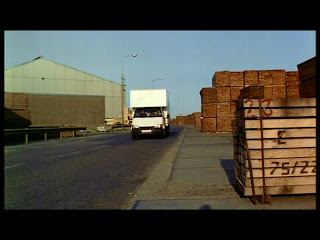This is the opening scene to Essex Boys
The shot of the garage reveals an old, unused car, covered in cobwebs and dust. Billy has to clear his way through this to get to the car. It is as if he is pushing aside the bad in his life in a carefree way, and suggests naivety. Non- ambient, chiaroscuro lighting is used to keep the scene dark. It distorts the vision of the audience, not revealing the entire scene, keeping the tension high in this first shot. The sound is only diegetic – the garage door, the sound of billy stealing the car, the car starting.
As well as the diegetic sounds, Billy’s voice is heard narrating the action. It introduces his character, as well as his strong essex accent.
The darkness in this shot surrounds Billy, yet he seems unaware of it.
The first image of Jason that the audience see's is unclear, and partially obscured by the dust on the windscreen. It is also taken from Billy’s point of view, which suggests that what Billy see’s Jason as is also obscured and distorted.
This shot shows the journey to the market through the Dartford tunnel. The empty roads suggest a solitary mission for Jason. The chiaroscuro lighting of the tunnel represents darkness surrounding the characters. The rule of thirds is used here: the circle of the tunnel is positioned to the left of the frame, and the road markings draws the eye to the vanishing point of the image. It helps to suggest distence, journey and makes the audience feel as though they're going on the journey with the characters.
The lights reflecting on the windscreen of the car are useful imagery as they are metaphors of jail bars across Billy’s face. It introduces the audience to the theme of crime within the film.
Also notice the position that Jason is in in the back of the car. He is lounging on the seat, showing his relaxation. It shows how he is the figure of authority.
The fish market is quite a strange setting, but it is used as a typically British location. This scene shocks the audience and introduces Jason’s violent character early into the film.
The shot from the wing mirror is from Billy’s perspective. It represents the distorted, surreal image of Jason that he sees. It shows that Billy doesn’t understand Jason’s actions.
The director has used another typically British indicator – the white van. It is a symbol of crime as a typical getaway vehicle. The director has used this to emphasize the Essex characters.
This location is generic because it is a wide open space, deserted marsh. It appears cold, wet and in the middle of nowhere. The rule of thirds draws the eye to the horizon, which exaggerates the expanse of the place where Jason was leaving the man.
The high shot used here is used to put Jason at a vulnerable place, the opposite to how the audience has perceived him up until then. The lion statue is made of gold which is precious and valuable. Jason’s gold, scruffy shirt contrasts the lion effectively, further demeaning Jason. The angle of the shot also makes the lion look like it is staring right down at Jason, putting him in a lower position than the statue and therefore the owner of the house.











I await your analysis of how the director of Essex Boys utilises specific conventions of the thriller genre, for example lighting, locations, camera shsots and angles, props and specific objects, i.e. the white van!
ReplyDeleteWell done for explaining the purpose of specific aspects of mise-en-scene, specifically lighting and camera angles.
ReplyDeleteYour post reflects your developing understanding of how directors utilise generic features in order to build suspense. Note the voice over (Billy's voice) is used for the audience to view the action from Billy's perspective.